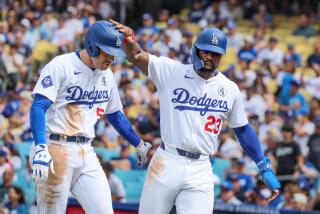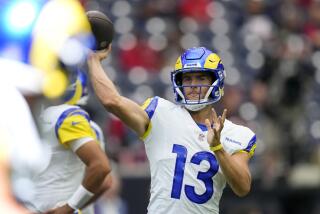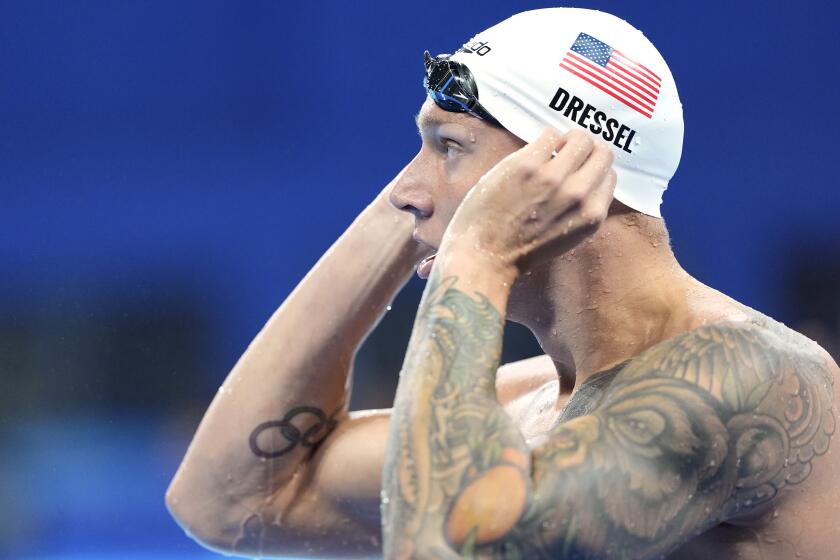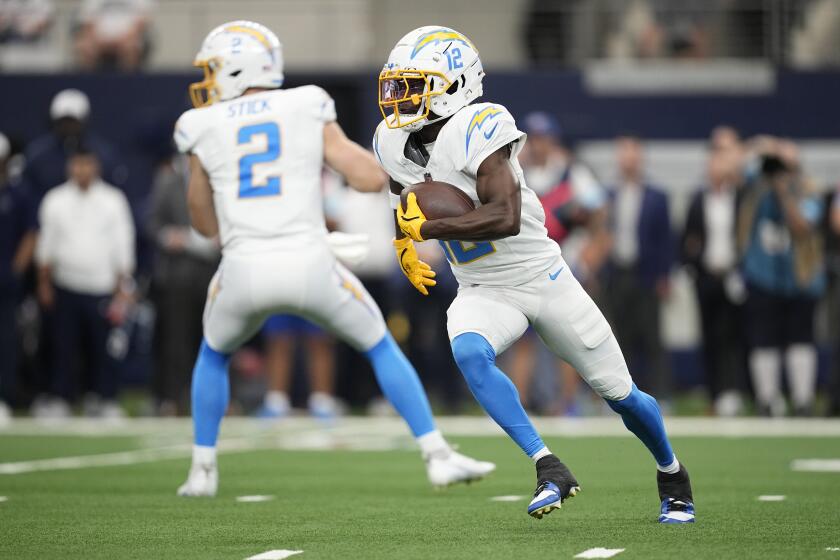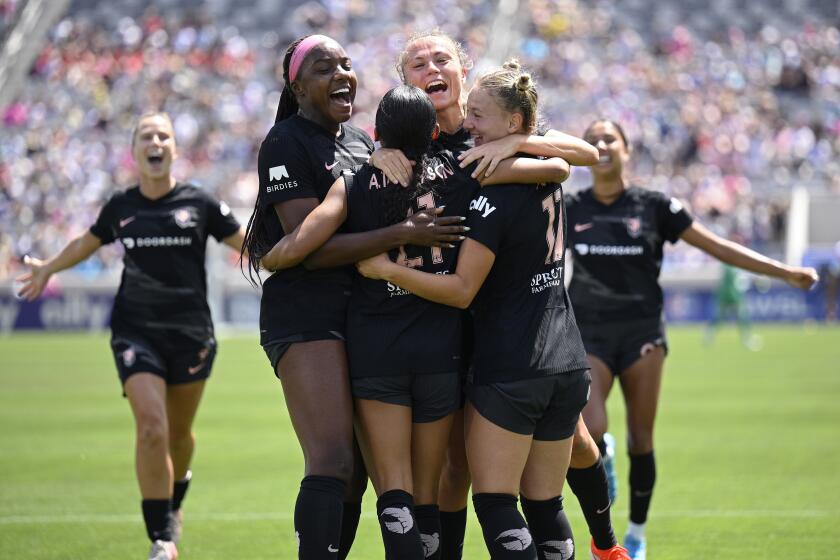The Literature of Baseball--The Joy Is in the Reading
The purple prose that marks baseball’s opening day like a bruise is fast becoming as much a rite of spring as rickety statesmen throwing out first balls.
A friend and editor recalls blushingly that he once wrote an opening-day leader for The Washington Star insisting that even to stare at an empty baseball diamond on rainy nights is a thing of great pleasure. “I’m not sure if I mentioned Zen contemplation or not,” he says. “But what the hell.” For weeks now he’s been crumpling little balls of paper, winding up and delivering his slider.
In spite of some of the spring wind that the early days of April tend to generate, I find that in an era when the financial and juridical issues of baseball dominate the sports page more than the games themselves, the literature of baseball has become more fun, more mysterious and textured than baseball itself. Given a choice of watching a World Series or reading Roger Angell’s account in The New Yorker months later, I’ll wait for the Angell.
One of the persistent themes in baseball writing is that it is a game played outside of time, unmarred by clocks or change. The game Pete Rose plays, many feel, is pretty much the one played by Ty Cobb. There is no clock, it is true, but the game has changed more over the years than nostalgists are willing to concede. One of baseball’s paradoxes is that the just battles of Curt Flood and Andy Messersmith against the reserve clause have produced a generation of millionaire mercenaries and disillusioned fans. Watching a Yankees-Orioles game now is about as pastoral and dreamlike as watching T. Boone Pickens go up against Carl Icahn in a merger fight.
The Boston-Cincinnati World Series of 1975 is a watershed, the last great autumn battle between two teams with indigenous players: Yastrzemski, Fisk, Lynn and Tiant for the Red Sox; Rose, Morgan, Bench, Perez and Foster for the Reds. With occasional interludes and happy regressions such as the Baltimore-Pittsburgh classic of 1979, the rise of today’s Yankees and other moneybag teams signaled the end. The age of classicism is over. Even the Orioles, once the symbol of cultural conservatism in baseball, feature Alan Wiggins, Lee Lacy, Fred Lynn and other soldiers of fortune.
For me, baseball was once a fantasy land of arcana, precision and grace, late nights spent listening via transistor radio to Horace Clarke whiff yet again in a faraway tropic called Anaheim. But by forcing the fan to take a hard look at all the scandals, hype and dollars--and there should be no escaping such reality--Oz suddenly looks as ordinary and dull as, well, Anaheim.
Happily the writing has blossomed as the game has withered. Baseball, like divorce, has become one of the richest sub-genres of American letters.
But baseball did not always produce the finest literature. Boxing was for a long time the sport of greatest inspiration. William Hazlitt’s “The Fight” is a bloody pleasure in an early 19th Century sort of way, and A.J. Liebling, the bard of the “sweet science of bruising” for The New Yorker, extended Hazlitt’s practice and passions in the era of Louis, Jersey Joe and Sugar Ray. Liebling died in 1963, too soon to confront both Ali and the killing effects of the sport he adored.
Baseball dominates the literature of sport now. There is a tradition for it. As the poet Donald Hall relates in “Fathers Playing Catch With Sons,” one of the earliest fans of the game was the country’s first great poet, Walt Whitman. Working as a general assignment reporter for the Brooklyn Eagle, Whitman learned the game just as it was maturing, and his conversation was peppered with metaphors: a great success was “a home stroke.”
Ever since the publication in the 1770s of the poem “Base Ball” (by Anonymous) about the early form of the game, poets as diverse as Marianne Moore (“Hometown Piece for Mssrs. Alton and Reese”), Gregory Corso (“Dream of a Baseball Star”) and Paul Goodman (“Don Larsen’s Perfect Game”) have gone to bat for the American pastime. Robert Fitzgerald’s “Cobb Would Have Caught It” was published 43 years ago in a volume entitled, presciently, “In the Rose of Time”:
“In sunburnt parks where Sundays lie,
Or the wide wastes beyond the cities,
Teams in gray deploy through sunlight.”
The main achievements, however, have been in prose. Charles Einstein’s three-volume anthology, “The Fireside Book of Baseball,” is an invaluable source, as is Gerald Secor Couzzens’ “A Baseball Album,” but this year my spring training has mostly been in “The Armchair Book of Baseball,” edited by John Thorn.
There is an unusually rich literature surrounding the sport, but I have tried to pick a few favorites as a spring warmup:
--The Prose of Obsession: Baseball provides children with a pleasurable route into the certainties of mathematics, and some adults, happily, cannot leave the inevitabilities and numbers of the game behind. Tom Boswell’s ornate discourse on his invention for ranking a player’s offensive value, the “total average,” is a pleasure, and so is Bill James’ Hall of Fame Prediction System.
But my favorite here is Stephen Jay Gould’s “The Extinction of the .400 Hitter.” As the world’s best-known explicator and critic of Darwinian theory, Gould contends that the decreasing range of highs and lows in batting averages can be explained as evolutionary theory. Just as the varieties of starfish, sea urchins and sea cucumbers have decreased, so too with batting averages. Gould proves his case with an occasional bar graph and consistently pellucid prose:
From this perspective, it occurred to me that we might be looking at the problem of .400 hitting the wrong way round. League-leading averages are extreme values within systems of variation. Perhaps their decrease through time simply records the standardization that affects so many systems as they stabilize. When baseball was young, styles of play had not become sufficiently regular to foil the antics of the very best. Wee Willie Keeler could “hit ‘em where they ain’t” (and compile a .432 average in 1897) because fielders didn’t yet know where they should be. Slowly, players moved toward optimal methods of positioning, fielding, pitching and batting--and variation inevitably declined.
Gould’s grasp of evolution and his passion for baseball are beyond question. Even if he is wrong, who cares?
--The Prose of Grandeur: As a self-hating Yankee fan, I think this category is almost wholly given to pinstripes. Robert W. Creamer’s biography of Babe Ruth is hours of grand fun--a Falstaffian figure with a magic cudgel--until the deathbed scene when, suddenly, the Babe, wasted with cancer, becomes a figure of great pathos. To philosophize, Montaigne wrote, is to learn how to die, and Creamer shows us Babe the philosopher. When he knew for sure cancer had beaten him, Ruth said to Connie Mack, “The termites have got me.”
The two towering shots in this category are John Updike’s celebrated piece on Ted Williams’ last day at bat at Fenway Park, “Hub Fans Bid Kid Adieu,” and Gay Talese’s profile of a remote Joe DiMaggio in retirement, “The Silent Season of a Hero.” With time, I’ve come to prefer Talese’s economy to Updike’s glissandi.
Talese describes the son of a fisherman who became “the most talked about man in America.” Now he is famous for his past, his skills on the ballfield, his brief marriage to Marilyn Monroe. It is a profile, on the grand scale, of a man with a broken heart. Here is Talese describing DiMaggio as he steps into the batting cage at an old-timer’s event:
The reporters waited silently. Then DiMaggio walked slowly into the cage and picked up Mantle’s bat. He took his position at the plate but obviously it was not the DiMaggio stance; he was holding the bat about two inches from the knob, his feet were not so far apart, and, when DiMaggio took a cut at Benson’s first pitch, fouling it, there was none of the ferocious follow through, the blurred bat did not come whipping all the way around, the No. 5 was not stretched full across his broad back.
DiMaggio fouled Benson’s second pitch, then he connected solidly with the third, the fourth, the fifth. He was just meeting the ball easily, however, not smashing it, and Benson called out, “I didn’t know you were a choke hitter, Joe.”
“I am now,” DiMaggio said, getting ready for another pitch.
He hit three more squarely enough, then he swung again and there was a hollow sound.
“Ohhh,” DiMaggio yelled, dropping his bat, his fingers stung, “I was waiting for that one.” He left the batting cage rubbing his hands together. The reporters watched him. Nobody said anything. Then DiMaggio said to one of them, not in anger or in sadness, but merely as a simply stated fact, “There was a time you couldn’t get me out of there.”
--Funny Men: Baseball satire and humor are rich. Certainly the biggest trove is provided by the ballplayers and managers themselves. While Casey Stengel was the seigneur of syntax, Yogi Berra--a truer yogi than any in all the Himalayas--is a master of malaprop and the paradox. Asked during spring training what his cap size was, The Supreme Yogi answered, “I don’t know. I’m not in shape yet.”
I’ve come late to Ring Lardner’s work and still seem to have a deaf ear for it--and so it’s up to others to celebrate “You Know Me Al.”
My vote goes to Philip Roth’s novel “The Great American Novel,” which features the Sumerian superstar Gil Gamesh. Some of Roth’s other players include Frenchy Astarte, Nickname Damur, Hothead Ptah, Jolly Cholly Tuminikar, Deacon Demeter, Howie Pollux, Mule Mokos and Applejack Terminus.
In an essay Roth wrote of the baseball childhood that lies behind his novel: “Just as I first learned the names of the great institutions of higher learning by trafficking in football pools for a neighborhood bookmaker rather than from our high school’s college adviser, so my feel for the American landscape came less from what I learned in the classroom about Lewis and Clark than from following the major league clubs on their road trips and reading about the minor leagues in the back pages of The Sporting News.”
--Sentiment, Nostalgia and Bathos, etc.: Roger Kahn’s memoir of the Brooklyn Dodgers, “The Boys of Summer,” is the favorite on Flatbush Avenue, perhaps, but I’m partial to Angell’s profiles of Steve Blass, the Pirates pitcher who lost it all, and “The Web of the Game,” an intricate narrative in which Angell sits with an old Red Sox ace, 91-year-old Smokey Joe Wood, and watches two young pitchers at their best, Ron Darling of Yale (now of the Mets) and Frank Viola of St. John’s:
“Our afternoon slid by in a distraction of baseball and memory. I almost felt myself at some dreamlike doubleheader involving the then and the now--the semi-anonymous strong young men waging their close, marvelous game on the sunlit green field before us while bygone players and heroes of baseball history--long gone now, most of them--replayed their vivid, famous innings for me in the words and recollections of my companion.”
What pleasure there is in the work of these baseball writers. Though most of the work tends toward the romantic and even the sentimental, the subject demands it.
Regrettably, there is a distressing trend within the literature, a cloying, bossy sort of newspaper column that relates, say, conservatism to the failures of the Chicago Cubs. These columns are meant to be friendly, but they come off as more self-involved than the political screeds they intersperse. It’s as if a bunch of high-rollers discovered your favorite little fish restaurant and killed it with kindness. A line at the door, high prices and a dress code are sure to follow.
But the best of baseball literature--and I’ve left out Peter Gammons’ hard-eyed studies of the Red Sox, Shirley Povich’s odes to the woeful Senators, Lawrence Ritter’s oral history, “The Glory of Their Times”--they all provide what the game itself used to provide, what the literary critic William Empson called a “version of the pastoral,” something that is without apparent importance and yet full of human effort, feeling and grace.
As for games themselves, I’ll take pro basketball; there is genius these days in Larry Bird’s Celtics, raw power in Magic Johnson’s Lakers. As for baseball, I’ll see you at the library.
More to Read
Go beyond the scoreboard
Get the latest on L.A.'s teams in the daily Sports Report newsletter.
You may occasionally receive promotional content from the Los Angeles Times.
